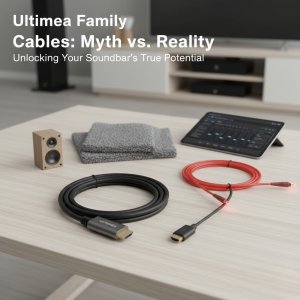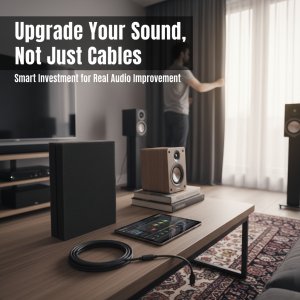harshjain1906
Well-known member
Hey Ultimea Family 
We’ve all seen those fancy “audiophile-grade” HDMI and optical cables that promise better clarity, deeper bass, and more immersive sound. But the real question is — can a cable alone actually change how your soundbar or home theater sounds?
Let’s break it down clearly and practically, based on how things really work.

HDMI cables carry digital signals — 0s and 1s.
That means the signal either arrives perfectly… or it doesn’t arrive at all. There’s no “slightly better” sound in between.
So, if your HDMI cable is working properly, you’ll get the same sound and picture quality, whether your cable costs $5 or $50.
So why do expensive ones exist? Because there are certain cases where a better-built HDMI helps:
Cable length: Once you cross 10–15 meters, cheaper cables can start losing signal strength.
High bandwidth formats: For Dolby Atmos, 4K HDR, or 120Hz gaming, you’ll need a cable rated HDMI 2.0 or 2.1.
Build quality: A sturdier cable with proper shielding and thicker connectors will last longer, especially if you plug/unplug often.
 Pro Tip: If you’re using an Atmos soundbar like Ultimea Skywave X series or Poseidon, just pick an HDMI 2.0 certified cable from a trusted brand — no need to overspend.
Pro Tip: If you’re using an Atmos soundbar like Ultimea Skywave X series or Poseidon, just pick an HDMI 2.0 certified cable from a trusted brand — no need to overspend.
Optical cables work differently - they transmit light signals instead of electricity. That means no electrical interference and very stable connections.
However, they have one key limitation -bandwidth.
Optical connections cannot carry the uncompressed Dolby Atmos signal; they’re limited to Dolby Digital or DTS.
That’s why most modern systems now prefer HDMI ARC or eARC.
Still, optical cables are great if:
• Your TV or receiver doesn’t support ARC/eARC.
• You want a clean, interference-free setup.
• You’re connecting older devices or budget soundbars.
 Fun Fact: A $10 optical cable performs the same as a $100 one — unless the cheap one is poorly made or physically damaged.
Fun Fact: A $10 optical cable performs the same as a $100 one — unless the cheap one is poorly made or physically damaged.
Let’s say you’re connecting your TV to a Dolby Atmos soundbar.
If both devices support eARC, a standard $10–$15 certified HDMI cable will deliver the exact same Dolby Atmos experience as a $100 “gold-plated” one.
The only time you’ll notice a difference is if the cheaper one starts to fail - causing flickering video or audio dropouts. That’s not “sound quality” - that’s just a connection issue.
So instead of worrying about marketing terms like “oxygen-free copper” or “ultra-pure transmission,” focus on what really matters:
• Certified HDMI version (2.0 or 2.1)
• Reasonable length (under 10 ft for most setups)
• Durable connectors and proper shielding
Rather than paying a premium for cables, here’s where your investment brings real improvement:
• Room acoustics - rugs, curtains, and soft walls reduce echo dramatically.
• Speaker/subwoofer placement - positioning can change how balanced your sound feels.
• Calibration - adjusting levels, distance, and EQ makes a huge difference.
In short: Good setup > Expensive cables every single time.
Cables are just messengers - they don’t “improve” the message.
As long as they’re good enough to deliver a clean digital signal, you’re already getting the best possible sound from your setup.
So next time someone tries to sell you an “ultra-premium audiophile HDMI” for double the price - just smile and save that money for something that actually enhances your sound.

Have you ever noticed a real difference between budget and premium cables in your setup?
Or maybe you’ve tested a few and found one surprisingly good?
Let’s share our experiences below - curious to know everyone’s take!

Harsh Jain

We’ve all seen those fancy “audiophile-grade” HDMI and optical cables that promise better clarity, deeper bass, and more immersive sound. But the real question is — can a cable alone actually change how your soundbar or home theater sounds?
Let’s break it down clearly and practically, based on how things really work.

HDMI Cables — What Really Matters
HDMI cables carry digital signals — 0s and 1s.
That means the signal either arrives perfectly… or it doesn’t arrive at all. There’s no “slightly better” sound in between.
So, if your HDMI cable is working properly, you’ll get the same sound and picture quality, whether your cable costs $5 or $50.
So why do expensive ones exist? Because there are certain cases where a better-built HDMI helps:
Cable length: Once you cross 10–15 meters, cheaper cables can start losing signal strength.
High bandwidth formats: For Dolby Atmos, 4K HDR, or 120Hz gaming, you’ll need a cable rated HDMI 2.0 or 2.1.
Build quality: A sturdier cable with proper shielding and thicker connectors will last longer, especially if you plug/unplug often.
Optical (Toslink) Cables — Still Great, But Limited
Optical cables work differently - they transmit light signals instead of electricity. That means no electrical interference and very stable connections.
However, they have one key limitation -bandwidth.
Optical connections cannot carry the uncompressed Dolby Atmos signal; they’re limited to Dolby Digital or DTS.
That’s why most modern systems now prefer HDMI ARC or eARC.
Still, optical cables are great if:
• Your TV or receiver doesn’t support ARC/eARC.
• You want a clean, interference-free setup.
• You’re connecting older devices or budget soundbars.
Real-World Example
Let’s say you’re connecting your TV to a Dolby Atmos soundbar.
If both devices support eARC, a standard $10–$15 certified HDMI cable will deliver the exact same Dolby Atmos experience as a $100 “gold-plated” one.
The only time you’ll notice a difference is if the cheaper one starts to fail - causing flickering video or audio dropouts. That’s not “sound quality” - that’s just a connection issue.
So instead of worrying about marketing terms like “oxygen-free copper” or “ultra-pure transmission,” focus on what really matters:
• Certified HDMI version (2.0 or 2.1)
• Reasonable length (under 10 ft for most setups)
• Durable connectors and proper shielding
Where You Should Spend Money Instead
Rather than paying a premium for cables, here’s where your investment brings real improvement:
• Room acoustics - rugs, curtains, and soft walls reduce echo dramatically.
• Speaker/subwoofer placement - positioning can change how balanced your sound feels.
• Calibration - adjusting levels, distance, and EQ makes a huge difference.
In short: Good setup > Expensive cables every single time.
Final Thoughts
Cables are just messengers - they don’t “improve” the message.
As long as they’re good enough to deliver a clean digital signal, you’re already getting the best possible sound from your setup.
So next time someone tries to sell you an “ultra-premium audiophile HDMI” for double the price - just smile and save that money for something that actually enhances your sound.

What about you, Ultimea fam?
Have you ever noticed a real difference between budget and premium cables in your setup?
Or maybe you’ve tested a few and found one surprisingly good?
Let’s share our experiences below - curious to know everyone’s take!
Harsh Jain
Last edited:
